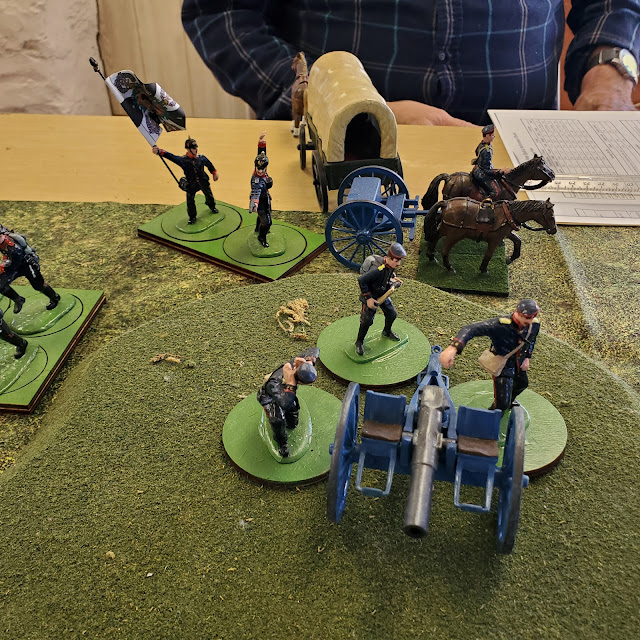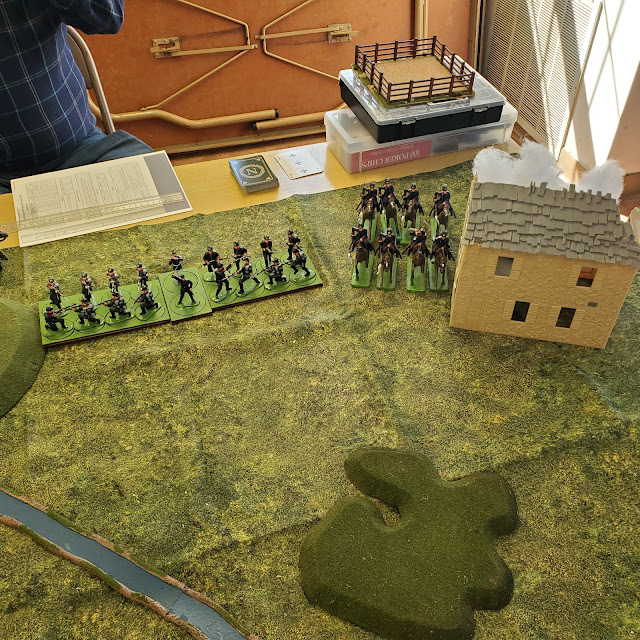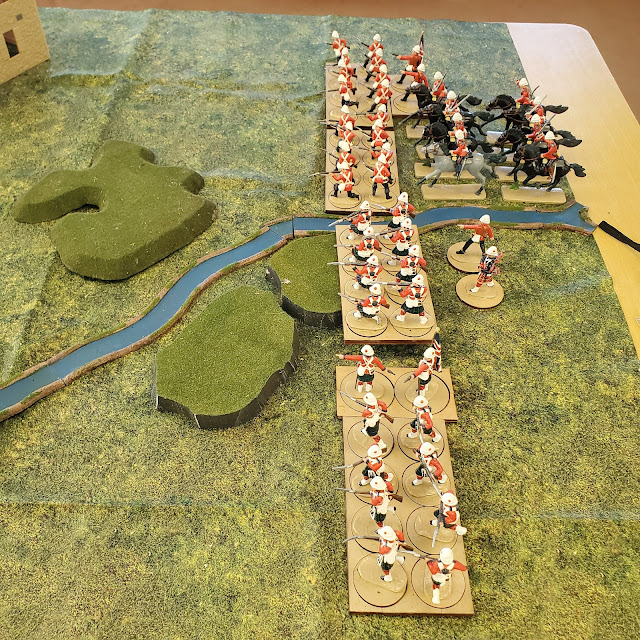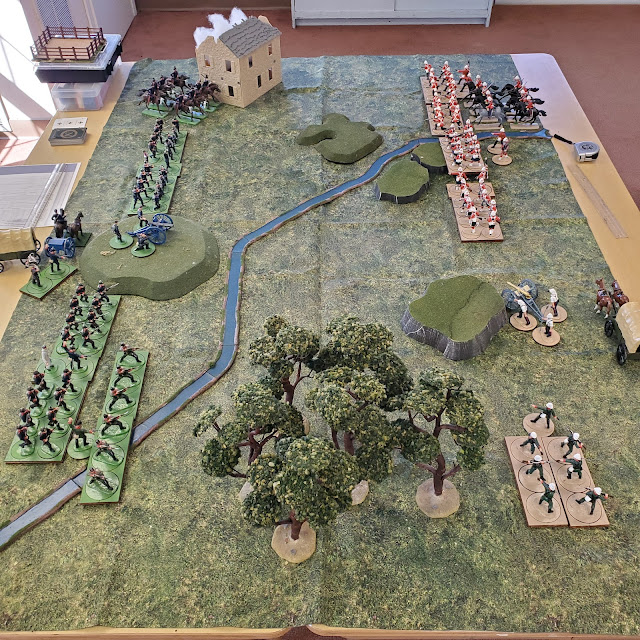Gen. Reginald von Frankenfurter supervises laying of his Krupp gun.
The laying of the gunners must be settled after the battle...
It's been a while since I dusted off and played that military masterpiece by Howard Whitehouse "A Gentleman's War" [ably assisted by Mr. Daniel Foley, Zoltan Korda, C. Aubrey Smith and June Duprez, oh wait...], so it was with zero hesitation that I invited Reg and his force of nicely shiny Blues and Reds [courtesy of Armies in Plastic] out to a game lunch and Pulp Action Library's biggest hit since TV went colorized:
Below, the Venerable General of a thousand tabletop battles and decorations and awards too numerous to count, Gen Reg von Frankenfurter, collects his thoughts before unleashing h**l against his opponent, Gen. Alexander Crumpets, and his Reds. Units are 7-10 figs in size, 7 each side, composed of four Infantry, one light, one light gun and one cavalry each.
As this was a first game for Blue, we decided on the simplest scenario "Open Battle" which ends when either side has driven half the opposition from the field, preferably before dinner.
Let's see what happened!
To Crumpet's right, Blues began with no unit in the house [hmmm....] a light cavalry and two Infantry towards the center.
The small rise counts as a hill. The stream counts as rough going as the Soldiers need to polish their shoes after crossing it.
Feldwebelanwärter Augustus von Frankfurter, his nephew.
"Feuer! Feuer! Entfesseln Sie die Holle!" he cries, brandishing his Walther PPK.
Hmmm... this all seems somewhat familiar...need more woods perhaps?
Meanwhile, the Dull Rifles company keeps the jagers busy in the woods.
As the sun begins westering [a late brunch was had by all] Gen Crumpet unleashes the "Lucky 13th" Kings Own Nobby-knackered Horse upon the rear of the fleeing Lancers!
Unfortunately, they were able to turn around and order themselves quickly. Altho they took the charge at the halt, outnumbered, their pig-stickers apparently made up for it and they were able to drive off the Lucky 13th, Disordered and with quite some losses. This set back was somewhat compensated for by the Fusiliers seizure of the house, which has the Blue left somewhat Flummuxed...or was that Confounded?
Meanwhile, the Prussian left holds grimly to the ground upon which they stand, despite numerous morale checks caused by significant losses: the cavalry and an infantry at 50%, the other infantry at 33%.
The Islays hold the center, but the Blues have ammassed a Brigade of shooting and a short card cycle, while the one Fusilier company and the Lucky 13th are reduced to a single figure apiece, as is the Whitworth.
Between lack of urgency, checking the rules and plenty of conversation, the time was coming to a close and the British were getting the worst of it by the end.
Despite a Plan clever enough to be thought of by a Fox that read Clever at Cambridge, poor morale rolls halted the British advance on the right. This was compounded by the British failure to organize a Brigade firing line quickly enough to handle the firepower of the Blue Infantry and Krupp gun.
Most interesting about the game was the card-driven sequence, which admirably kept the game interesting but rewarded thoughtful play. It is undoubtedly the most unusual and well-developed aspect of these rules, turning it from "just another colorful and fun set of old-school rules" into A Thinking Gentleman's War that is rewarding to get acquainted with and pull out regularly.
As previously commented upon in my Franco-Prussian playtest, the card sequence admirably handles the friction of battle by turning cards from a single deck, sequentially, allowing one Unit to activate on a number and up to four units to "brigade" and activate on a face card - but they all must do the same thing. Generals can have a bit impact by making it easier to Brigade, but you can't activate a force again until your card sequence ends with every unit having activated.
Thus, it is smart to Brigade as often as possible, perhaps on two "Wings" of a small force, one moving, the other firing. However, when units fail morale, they Run Away and break up the Brigade. All of this takes care of generalship and tactics quite admirably [with a bunch of other little twists I shan't reveal" making the card sequence worth the price of the rules alone, IMHO. It would work with most rules and fighting mechanics.
We both enjoyed ourselves, and plan to play "A Gentleman's War" again soon, perhaps with another set of Reg's figures, 28mm Germans and Japanese from 1915, which sound exotic and interesting to me!
The 54's were very much in the spirit of the game and fun to look at. 40s and 28s would also be enjoyable and leave more space on the 6x4 table for bigger units. As the units were identical on both sides, this didn't matter but Medium Armies of 10--13 Units would definitely need an 8' table I'd say.
Until next time, watch your flanks and keep your sherry dry!



















nice report/review
ReplyDeleteThanks! and thanks for dropping by!
DeleteIt's hard not to love the look of a game featuring red-coated Highlanders! The rules sound intriguing. Unfortunately it sounds like I don't have nearly enough figures to give them a fair shake. What do you think the sweet spot is for these rules for number of units per side? Is 7-10 figures per unit from the rules or from the collection you were using?
ReplyDeleteThe rules present Small, Medium and Large armies. I think a force of 4-6 Infantry, 1-2 Cav, 1-2 Guns gives enough variety to be tactically interesting. Infantry are suggested at 12, Cavalry at 6-8. From what I've seen with your 54mm project - British v. Russian at the back of beyond, you may want to look at skirmish rules with 1 fig = 1 man. That gives you plenty to do. I have a set that I used for a 54mm FIW game I posted about a while back. You could try those out.
ReplyDelete